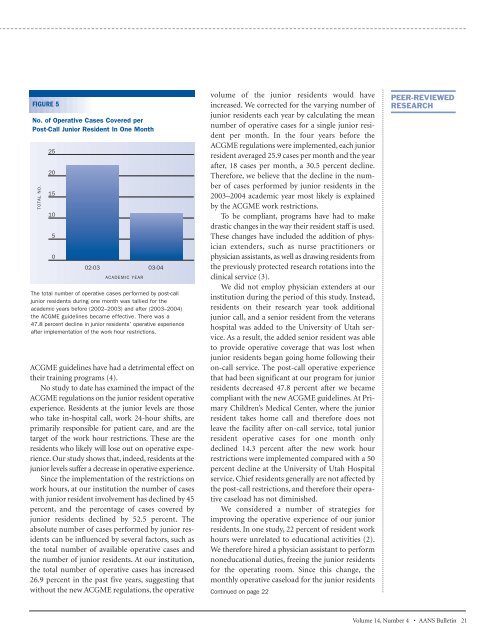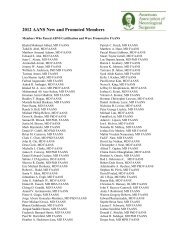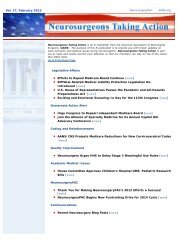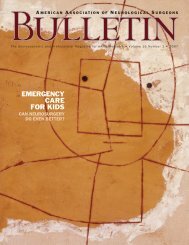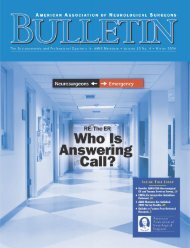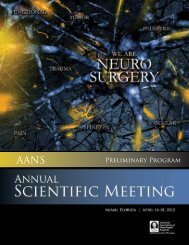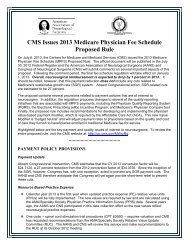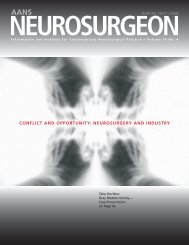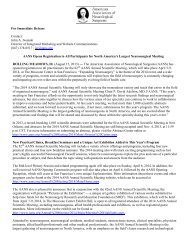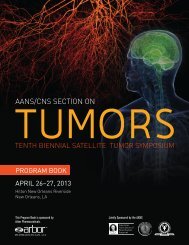view PDF - American Association of Neurological Surgeons
view PDF - American Association of Neurological Surgeons
view PDF - American Association of Neurological Surgeons
Create successful ePaper yourself
Turn your PDF publications into a flip-book with our unique Google optimized e-Paper software.
FIGURE 5<br />
No. <strong>of</strong><br />
Operative<br />
Operative<br />
Cases<br />
Cases Covered<br />
Covered<br />
per<br />
by Post-call<br />
Post-Call Junior Junior Residents Resident in In One One Month Month<br />
TOTAL NO.<br />
25<br />
20<br />
15<br />
10<br />
5<br />
0<br />
02-03 03-04<br />
ACADEMIC YEAR<br />
The total number <strong>of</strong> operative cases performed by post-call<br />
junior residents during one month was tallied for the<br />
academic years before (2002–2003) and after (2003–2004)<br />
the ACGME guidelines became effective. There was a<br />
47.8 percent decline in junior residents’ operative experience<br />
after implementation <strong>of</strong> the work hour restrictions.<br />
experience. Residents at the junior levels are those<br />
who take in-hospital call, work 24-hour shifts, are<br />
primarily responsible for patient care, and are the<br />
target <strong>of</strong> the work hour restrictions. These are the<br />
residents who likely will lose out on operative experience.<br />
Our study shows that, indeed, residents at the<br />
junior levels suffer a decrease in operative experience.<br />
Since the implementation <strong>of</strong> the restrictions on<br />
work hours, at our institution the number <strong>of</strong> cases<br />
with junior resident involvement has declined by 45<br />
percent, and the percentage <strong>of</strong> cases covered by<br />
junior residents declined by 52.5 percent. The<br />
absolute number <strong>of</strong> cases performed by junior residents<br />
can be influenced by several factors, such as<br />
the total number <strong>of</strong> available operative cases and<br />
the number <strong>of</strong> junior residents. At our institution,<br />
the total number <strong>of</strong> operative cases has increased<br />
26.9 percent in the past five years, suggesting that<br />
without the new ACGME regulations, the operative<br />
volume <strong>of</strong> the junior residents would have<br />
increased. We corrected for the varying number <strong>of</strong><br />
junior residents each year by calculating the mean<br />
number <strong>of</strong> operative cases for a single junior resident<br />
per month. In the four years before the<br />
ACGME regulations were implemented, each junior<br />
resident averaged 25.9 cases per month and the year<br />
after, 18 cases per month, a 30.5 percent decline.<br />
Therefore, we believe that the decline in the number<br />
<strong>of</strong> cases performed by junior residents in the<br />
2003–2004 academic year most likely is explained<br />
by the ACGME work restrictions.<br />
To be compliant, programs have had to make<br />
drastic changes in the way their resident staff is used.<br />
These changes have included the addition <strong>of</strong> physician<br />
extenders, such as nurse practitioners or<br />
physician assistants, as well as drawing residents from<br />
the previously protected research rotations into the<br />
clinical service (3).<br />
We did not employ physician extenders at our<br />
institution during the period <strong>of</strong> this study. Instead,<br />
residents on their research year took additional<br />
junior call, and a senior resident from the veterans<br />
hospital was added to the University <strong>of</strong> Utah service.<br />
As a result, the added senior resident was able<br />
to provide operative coverage that was lost when<br />
junior residents began going home following their<br />
on-call service. The post-call operative experience<br />
that had been significant at our program for junior<br />
residents decreased 47.8 percent after we became<br />
ACGME guidelines have had a detrimental effect on<br />
their training programs (4).<br />
No study to date has examined the impact <strong>of</strong> the<br />
ACGME regulations on the junior resident operative compliant with the new ACGME guidelines. At Pri<br />
. . . . . .<br />
mary Children’s Medical Center, where the junior<br />
resident takes home call and therefore does not<br />
leave the facility after on-call service, total junior<br />
resident operative cases for one month only<br />
declined 14.3 percent after the new work hour<br />
restrictions were implemented compared with a 50<br />
percent decline at the University <strong>of</strong> Utah Hospital<br />
service. Chief residents generally are not affected by<br />
the post-call restrictions, and therefore their operative<br />
caseload has not diminished.<br />
We considered a number <strong>of</strong> strategies for<br />
improving the operative experience <strong>of</strong> our junior<br />
residents. In one study, 22 percent <strong>of</strong> resident work<br />
hours were unrelated to educational activities (2).<br />
We therefore hired a physician assistant to perform<br />
noneducational duties, freeing the junior residents<br />
for the operating room. Since this change, the<br />
monthly operative caseload for the junior residents<br />
Continued on page 22<br />
PEER-REVIEWED<br />
RESEARCH<br />
Volume 14, Number 4 • AANS Bulletin 21


